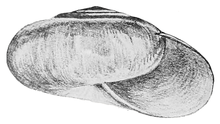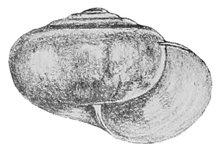Staffordiidae
Staffordiidae is a family of air-breathing land snails, terrestrial pulmonate gastropod mollusks in the superfamily Staffordioidea (according to the taxonomy of the Gastropoda by Bouchet & Rocroi, 2005).
| Staffordiidae | |
|---|---|
 | |
| A drawing of an apertural view of a shell of Staffordia daflaensis | |
| Scientific classification | |
| Kingdom: | |
| Phylum: | |
| Class: | |
| (unranked): | clade Heterobranchia clade Euthyneura clade Panpulmonata clade Eupulmonata clade Stylommatophora informal group Sigmurethra clade limacoid clade |
| Superfamily: | Staffordioidea Thiele, 1931 |
| Family: | Staffordiidae |
| Genera | |
|
See text | |
Staffordiidae is the only family in the superamily Staffordioidea. This family has no subfamilies (according to the taxonomy of the Gastropoda by Bouchet & Rocroi, 2005).
Staffordiidae is a poorly understood[2] family, because it occurs only in the Dafla Hills area of India. The fauna and flora of that area has not been researched sufficiently.[2]
Various sources consider the family Staffordiidae as part of Dyakiidae[3] or Ariophantidae/Dyakiinae.[4]
Distribution
The distribution of the Staffordiidae includes only India in the Dafla Hills.[2]
This area is close to northern margin of the Indian plate.[2] The historical area of origin of the Staffordiidae has not been researched because the coastal area in southern Asia where it is found became uninhabitable[2] after the Indian Plate and Eurasian Plate collided 50 to 55 million years ago. The original ancestral area of limacoid families is thought to be the Palaearctic region and south-eastern Asia.[2] Thus, it has been hypothesized that the Staffordiidae colonized its current area from the southern margin of the Asian part of the Eurasian Plate during the Oligocene period.[2]
Genera
Genera within the family Staffordiidae include:
- Staffordia Godwin-Austen, 1907[5] – type genus of the family
- Staffordia daflaensis (Godwin-Austen)[4]
- Staffordia staffordi Godwin-Austen, 1907[4][5]
- Staffordia toruputuensis Godwin-Austen[4]
The generic name Staffordia is in honor of Brigadier-General Stafford, who was in command of the punitive force which entered the Dafla Hills for the first time in the winter of 1874–1875.[5]
The foot of Staffordia is pointed.[5] The peripodial margin is simple with a narrow pale margin.[5] There are small right and left shell-lobes.[5]
Reproductive system of Staffordia: the dart-sac is small, globose, with a long cord-like attachment to a coronal gland.[5] The penis is simple.[5] The spermatheca is long.[5]
The radula of Staffordia has aculeate lateral teeth.[5]
Comparison of shells of three Staffordia species:
 type specimen of Staffordia staffordi is juvenile |
 type specimen of Staffordia toruputuensis is juvenile |
Cladogram
Staffordiidae is considered a sister group of all other families in the limacoid clade.[2]
The following cladogram shows the phylogenic relationships of this family and superfamily to the other families within the limacoid clade:[2]
| limacoid clade |
| ||||||||||||||||||||||||||||||||||||||||||||||||||||||||||||||||||||||||||||||||||||||||||||||||||||||
References
This article incorporates public domain text from the reference.[5]
- Thiele J. (1931). Handbuch der systematischen Weichtierkunde Fischer, Jena, 1(2): 632.
- Hausdorf B. (2000). "Biogeography of the Limacoidea sensu lato (Gastropoda: Stylommatophora): Vicariance Events and Long-Distance Dispersal". Journal of Biogeography 27(2): 379–390. doi:10.1046/j.1365-2699.2000.00403.x, JSTOR.
- Barker G. M. (2001) Gastropods on Land: Phylogeny, Diversity and Adaptive Morphology. 1–146. In: Barker G. M. (ed.) (2001) The biology of terrestrial molluscs. CABI Publishing, Oxon, UK, cited pages: 139–144. ISBN 0-85199-318-4.
- Ramakrishna, Dey A. & Mitra S. C. (PDF created 6 April 2010). "Checklist of Indian Land Mollusca" Archived 17 September 2013 at the Wayback Machine. Zoological Survey of India. accessed 30 June 2010. 65 pp.
- Godwin-Austen H. H. (1907). Land and freshwater mollusca of India, including South Arabia, Baluchistan, Afghanistan, Kashmir, Nepal, Burma, Pegu, Tenasserim, Malaya Peninsula, Ceylon and other islands of the Indian Ocean; Supplementary to Masers Theobald and Hanley's Conchologica Indica. Taylor and Francis, London. 2: page 184, plate CXIII.
Further reading
- Schileyko A. A. (2003). "Treatise on recent terrestrial pulmonate mollusks. 10. Ariophantidae, Ostracolethaidae, Ryssotidae, Milacidae, Dyakiidae, Staffordiidae, Gastrodontidae, Zonitidae, Daudebardiidae, Parmacellidae". Ruthenica, Supplement 2. 1309–1466.
External links
| Wikimedia Commons has media related to Staffordiidae. |